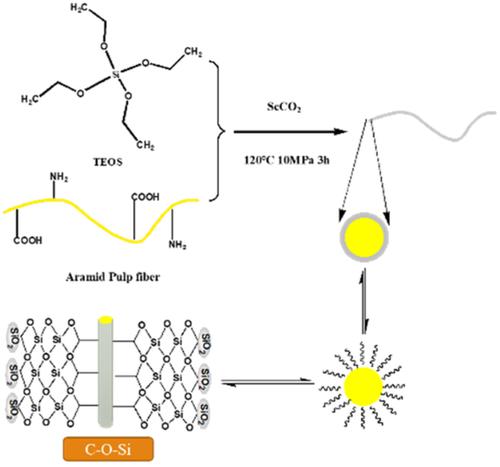当前位置:
X-MOL 学术
›
Polym. Compos.
›
论文详情
Our official English website, www.x-mol.net, welcomes your
feedback! (Note: you will need to create a separate account there.)
Effects of different supercritical temperatures on the modification of aramid pulp surface via coating silica to enhance the properties of EPDM composites
Polymer Composites ( IF 4.8 ) Pub Date : 2020-12-23 , DOI: 10.1002/pc.25917 Qian Xu 1 , Haijuan Kong 1, 2 , Haiquan Ding 1 , Juan Zeng 1 , Feiyan Jiang 1 , Xue Du 1 , Biao Li 1 , Muhuo Yu 3
Polymer Composites ( IF 4.8 ) Pub Date : 2020-12-23 , DOI: 10.1002/pc.25917 Qian Xu 1 , Haijuan Kong 1, 2 , Haiquan Ding 1 , Juan Zeng 1 , Feiyan Jiang 1 , Xue Du 1 , Biao Li 1 , Muhuo Yu 3
Affiliation

|
Poor dispersion is a major disadvantage of aramid pulp (AP) reinforced composites. In this study, nano‐silica (SiO2), as the surface modifier and reinforcing agent, was synthesized on AP surfaces to improve the dispersed character in ethylene‐propylene‐diene elastomer (EPDM) using supercritical carbon dioxide (scCO2). The influence of the temperature of scCO2 on treated AP, configuration of the surface, and mechanical performance of AP/EPDM composites were studied. Based on the results of Fourier transform infrared spectroscopy and X‐ray photoelectron spectroscopy, SiO2 was chemically grafted onto the AP surface. The SiO2 nanoparticles were uniformly deposited on the AP surface, and the roughness of AP was increased based on the SEM results. The optimum temperature of the supercritical reaction was 100°C considering the results of all the tests. Under the optimum temperature and with 10 phr of AP, the mechanical properties, oil resistance, and dynamic mechanical properties of the SiO2‐AP/EPDM composites were investigated. The tensile strength and tear strength of the SiO2‐AP/EPDM were improved by 121.1 and 134.9%, respectively, compared with that of the pure AP/EPDM composites. The fracture surface of the SiO2‐AP/EPDM composites showed that SiO2‐modified AP had a good dispersion in EPDM, and AP and EPDM had good interfacial bonding. Dynamic mechanical analysis results showed that the storage modulus of the composites was improved greatly compared with the pure AP/EPDM, and the loss factor also increased. The oil resistance of the composites was also improved.
中文翻译:

不同超临界温度对涂覆二氧化硅提高芳纶浆粕复合材料性能对芳纶浆粕表面改性的影响
分散性差是芳纶纸浆(AP)增强复合材料的主要缺点。在这项研究中,使用超临界二氧化碳(scCO 2)在AP表面合成了纳米二氧化硅(SiO 2)作为表面改性剂和增强剂,以改善乙烯-丙烯-二烯弹性体(EPDM)中的分散特性。研究了scCO 2温度对处理过的AP,AP / EPDM复合材料的表面形态和机械性能的影响。根据傅立叶变换红外光谱和X射线光电子能谱的结果,将SiO 2化学接枝到AP表面。SiO 2纳米粒子均匀地沉积在AP表面上,并且基于SEM结果增加了AP的粗糙度。考虑到所有测试的结果,超临界反应的最佳温度为100°C。在最适温度和10 phr AP的条件下,研究了SiO 2 -AP / EPDM复合材料的力学性能,耐油性和动态力学性能。与纯AP / EPDM复合材料相比,SiO 2 ‐AP / EPDM的拉伸强度和撕裂强度分别提高了121.1%和134.9%。SiO 2 -AP / EPDM复合材料的断口表明,SiO 2改性的AP在EPDM中具有良好的分散性,并且AP和EPDM具有良好的界面键合。动态力学分析结果表明,与纯AP / EPDM相比,复合材料的储能模量有较大提高,损耗因子也有所增加。复合材料的耐油性也得到了改善。
更新日期:2020-12-23
中文翻译:

不同超临界温度对涂覆二氧化硅提高芳纶浆粕复合材料性能对芳纶浆粕表面改性的影响
分散性差是芳纶纸浆(AP)增强复合材料的主要缺点。在这项研究中,使用超临界二氧化碳(scCO 2)在AP表面合成了纳米二氧化硅(SiO 2)作为表面改性剂和增强剂,以改善乙烯-丙烯-二烯弹性体(EPDM)中的分散特性。研究了scCO 2温度对处理过的AP,AP / EPDM复合材料的表面形态和机械性能的影响。根据傅立叶变换红外光谱和X射线光电子能谱的结果,将SiO 2化学接枝到AP表面。SiO 2纳米粒子均匀地沉积在AP表面上,并且基于SEM结果增加了AP的粗糙度。考虑到所有测试的结果,超临界反应的最佳温度为100°C。在最适温度和10 phr AP的条件下,研究了SiO 2 -AP / EPDM复合材料的力学性能,耐油性和动态力学性能。与纯AP / EPDM复合材料相比,SiO 2 ‐AP / EPDM的拉伸强度和撕裂强度分别提高了121.1%和134.9%。SiO 2 -AP / EPDM复合材料的断口表明,SiO 2改性的AP在EPDM中具有良好的分散性,并且AP和EPDM具有良好的界面键合。动态力学分析结果表明,与纯AP / EPDM相比,复合材料的储能模量有较大提高,损耗因子也有所增加。复合材料的耐油性也得到了改善。











































 京公网安备 11010802027423号
京公网安备 11010802027423号